Rag quilts are fun to make--especially for children because they are easy to sew; sturdy enough for multi-launderings; and the soft, warm flannel appeals to the kids. I have a lot of fun making these quilts for my young granddaughters. There are so many colorful children's fabrics. At first I made my rag quilts with only flannel, but lately I have been mixing both 100% cotton and flannel. This allows me even many more fabric options.
The most time consuming and tedious part of making a rag quilt is the final act of snipping all of the seams and borders. The first rag quilt I made, I used my regular sewing scissors. Not only was this difficult but painful--my thumbs had blisters by the time I was done. Luckily, the quilting-blog world offers the most helpful information and a short search told me that I could buy snippers to "snip" my seams. Boy, they really do make the snipping absolutely easy (and painless)!
When attending one of my Block of the Month classes at the local fabric store, the The AccuQuilt! Go Cutting Machine was demonstrated and received high praise for its precision and time-saving factor.
I had only a passing interest in the machine and thought little more about it until I discovered that AccuQuilt offered the 8-1/2 inch; Rag Square die. I thought, "wouldn't it be fantastic to NOT have to do any final snipping of the seams?"
Now I am the proud owner of an AccuQuilt Go! Cutting Machine with the aforementioned 8-1/2 inch Rag Square die. (The decision to purchase was not that quick and simple--after all it takes a lot of self talk to justify the cost versus the time-saving factor when you are retired.)
Now that I have used my cutting machine and rag square die to make the latest rag quilt I thought I might share my experience using it with anyone who is interested.
I made the quilt with flannel and 100% cotton. The cutting machine directions said, for flannel, cut the maximum of two layers at a time. For cotton, it was recommended that you start with two layers and build up to six layers. I found that I could cut 4 layers of the flannel quite easily and accurately. The cutting process took some planning so as not to waste fabric. I cut 9 inch squares to make my rag cuts. You might say, "what's the point, why use a cutting machine if you have to do pre-cutting?"
Well, it's about the entire process--remember you don't have to do all that snipping later on.
And, the resulting rag squares were beautiful to behold--with lovely, perfectly formed, perfectly spaced fringes. Sigh!
Layering the fabric into little sandwiches was easy peasy. I placed 6 inch squares of white flannel between my fringed 8-1/2 inch squares ....
and sewed an "X" across each sandwich square.
Then I sewed the sandwich squares together in rows.
All so easy, yes? Well, no because when I turned over my sewn row of squares here is what I saw.
 |
| Peekaboo fringes |
And this......
 |
Helter skelter fringes
|
I found it very difficult to manage those gorgeous, long fringes. Even though I ever-so-carefully pinned and sewed, they seemed to have a minds of their own--popping out and turning up where they were not meant to be.
Another challenge was sewing the rows together when four seams intersected. The dilemma was--how to sew through or around the intersecting fringes. A picture is worth a thousand words, here is what I mean.
 |
My thumb is placed where the seam should be sewn. Those vertical fringes are in the way.
|
My solution to this problem was to snip/remove a few of the intersecting fringes. I decided that a few fringes would not be missed once all was sewn together and the rows were brushed into fluffy goodness. (Yes, I used a plastic brush to make my fringes fluffy.)
Here is the final product.
 |
| Front |
 |
| Another view of front |
 |
And paper-pieced label makes it complete
|
 |
| Back view |
QUESTION: Was the AccuQuilt Machine and 8-1/2 inch Die Cutter worth the expense of purchase?
ANSWER: The cost can be prohibitive for many and might not compensate for the resulting
finished product in this case.
QUESTION: Will I save time and effort?
ANSWER: Yes, overall time spent was much less because there was no "snipping" needed.
Yes, the process was more efficient once I learned how to deal with the errant fringes
and intersecting rows of fringes.
CONCLUSION: The AccuQuilt cutting machine produced perfectly cut squares with beautifully,
symmetric and long, lovely fringes that could never be produced by hand cutting.
The resulting product was well worth using the AccuQuilt cutting machine and its
8-1/2 inch die.
If you can afford the cutting machine, buy it! Later you can purchase additional
dies for making perfect half-square triangles, squares, strips, circles, etc., in the
most commonly used sizes for making quilts.










































